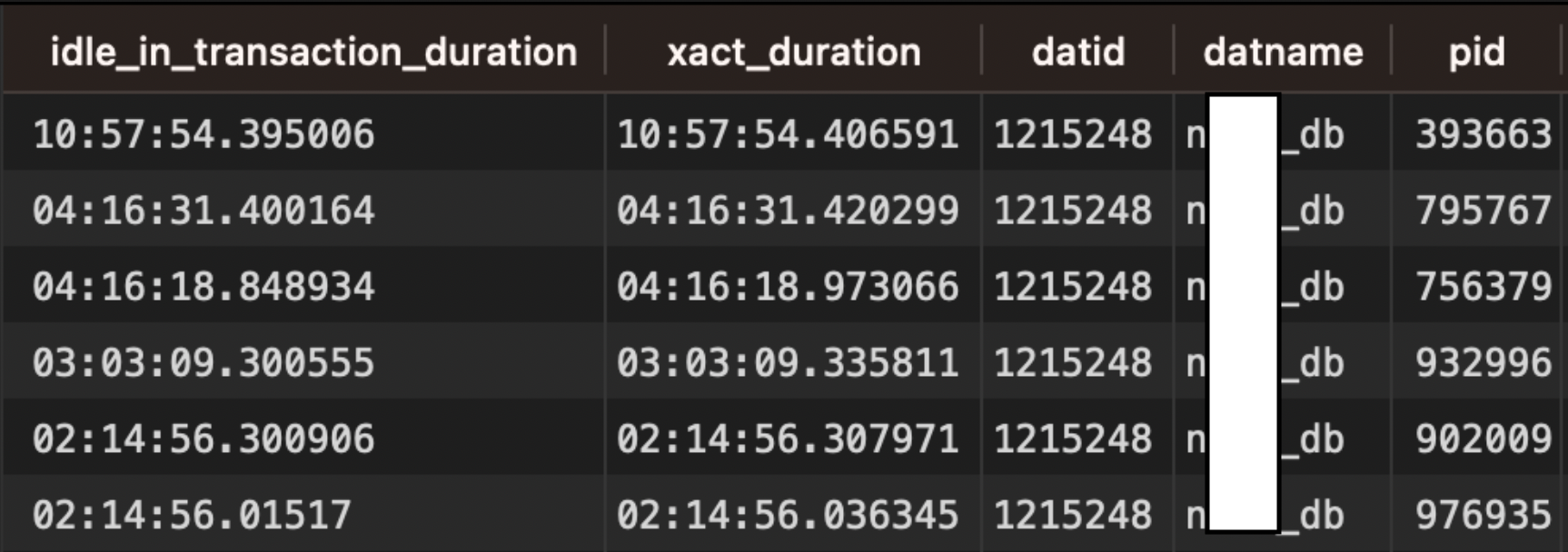Resolving Postgres Idle in Transaction Errors: An Effective Solution
Once upon a time, on a fine weekend, while I was hanging out with my friends, a work chat notification popped up with a beautiful message:
remaining connection slots are reserved for non-replication superuser connections
This meant our DB instance connection was full. It was time for the Avengers to assemble! All backend and DevOps team members went online to investigate the root cause. Thanks to the Cloud SQL monitoring dashboard, we quickly discovered an anomaly in the number of connections in idle in transaction state in one of our databases.
What is "idle in transaction" state
Picture this: You're in a crowded cafe, ready to tackle a big project. You claim a table (BEGIN transaction), order a coffee... and then proceed to stare into space, pondering the mysteries of life. That's your database connection in idle in transaction state. It has everything it needs to start working, but it's just... sitting there.
In other words, this means the transaction is open (inside BEGIN) but is currently inactive or idle.
How to check "idle in transaction" queries
Imagine the cafe manager, slightly annoyed at your table-hogging. They peek over your shoulder and politely ask, "Excuse me, sir, how long have you been idle in transaction? Also, might I inquire about your xact_start time?". That's essentially what this query does:
SELECT NOW() - state_change AS idle_in_transaction_duration, NOW() - xact_start AS xact_duration,*
FROM pg_stat_activity
WHERE state = "idle in transaction"
AND xact_start IS NOT NULL
ORDER BY 1 DESC;
And you will see long-running queries with connection state of idle in transaction like this. Apologies for the 10-hour idle duration! That's definitely not ideal. 😢

How to prevent "idle in transaction" state
Database Configuration
Back to our cafe scenario. The manager, having had enough of your daydreaming, tactfully suggests, "Perhaps we could set a little idle_in_transaction_session_timeout for your table? You know, just to make sure everyone gets a chance to enjoy our fine establishment." In Postgres terms, this means setting a limit on how long a transaction can remain idle before getting politely kicked out.
ALTER DATABASE database-name SET idle_in_transaction_session_timeout='60s'
You can verify the configuration by running this query:
SELECT name, setting FROM pg_settings
WHERE name = 'idle_in_transaction_session_timeout';
Application Code Best Practices
Alright, database wizards! Now that we've fortified our Postgres fortress with the right configuration, let's dive into the magical realm of application code. Remember, even the most powerful spells can fizzle out if not cast with precision and care. So, let's conjure some best practices to keep those idle transactions at bay!
- Keep transactions short ⌛️: Nobody likes a long-winded monologue, not even your database. Avoid performing lengthy computations or blocking operations within a transaction. If necessary, break down complex transactions into smaller ones.
- Explicitly commit or rollback 🪄: Just like a good magician never leaves a trick unfinished, always explicitly commit or rollback your transactions when they've served their purpose. Relying on implicit commits or auto-commits can lead to transactions remaining open for longer than necessary.
- Handle errors gracefully 🧨: Even the best performers encounter mishaps. Implement proper error handling mechanisms to ensure that transactions are rolled back in case of errors. Unhandled exceptions can leave transactions open, leading to the "idle in transaction" state.
Wrapping Up
The idle in transaction state in Postgres is like that moment of procrastination we all experience from time to time. It's harmless in small doses, but if left unchecked, it can lead to problems. By understanding this state, monitoring for idle transactions, and setting appropriate timeouts, you can keep your database running smoothly and efficiently. Remember, a happy database is a productive database!
References
- https://stackoverflow.com/questions/51019/what-does-it-mean-when-a-postgresql-process-is-idle-in-transaction
- https://docs.aws.amazon.com/AmazonRDS/latest/AuroraUserGuide/proactive-insights.idle-txn.html
- https://www.postgresql.org/docs/current/runtime-config-client.html#GUC-IDLE-IN-TRANSACTION-SESSION-TIMEOUT